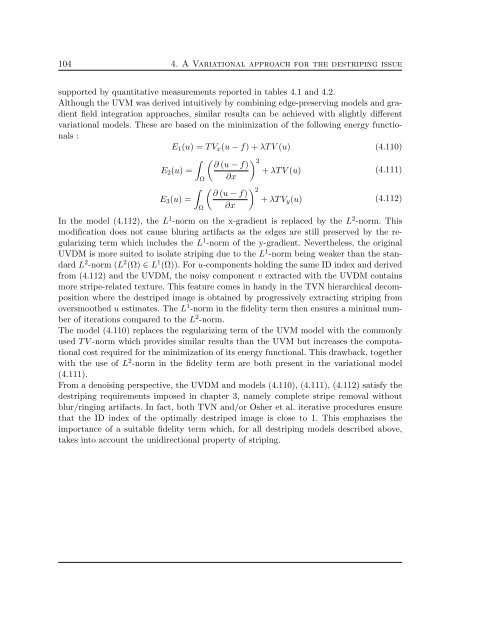Th`ese Marouan BOUALI - Sites personnels de TELECOM ParisTech
Th`ese Marouan BOUALI - Sites personnels de TELECOM ParisTech
Th`ese Marouan BOUALI - Sites personnels de TELECOM ParisTech
Create successful ePaper yourself
Turn your PDF publications into a flip-book with our unique Google optimized e-Paper software.
104 4. A Variational approach for the <strong>de</strong>striping issue<br />
supported by quantitative measurements reported in tables 4.1 and 4.2.<br />
Although the UVM was <strong>de</strong>rived intuitively by combining edge-preserving mo<strong>de</strong>ls and gradient<br />
field integration approaches, similar results can be achieved with slightly different<br />
variational mo<strong>de</strong>ls. These are based on the minimization of the following energy functionals<br />
:<br />
E 1 (u) =TV x (u − f)+λT V (u) (4.110)<br />
∫ ( ) ∂ (u − f) 2<br />
E 2 (u) =<br />
+ λT V (u) (4.111)<br />
Ω ∂x<br />
∫ ( ) ∂ (u − f) 2<br />
E 3 (u) =<br />
+ λT V y (u) (4.112)<br />
∂x<br />
Ω<br />
In the mo<strong>de</strong>l (4.112), the L 1 -norm on the x-gradient is replaced by the L 2 -norm. This<br />
modification does not cause bluring artifacts as the edges are still preserved by the regularizing<br />
term which inclu<strong>de</strong>s the L 1 -norm of the y-gradient. Nevertheless, the original<br />
UVDM is more suited to isolate striping due to the L 1 -norm being weaker than the standard<br />
L 2 -norm (L 2 (Ω) ∈ L 1 (Ω)). For u-components holding the same ID in<strong>de</strong>x and <strong>de</strong>rived<br />
from (4.112) and the UVDM, the noisy component v extracted with the UVDM contains<br />
more stripe-related texture. This feature comes in handy in the TVN hierarchical <strong>de</strong>composition<br />
where the <strong>de</strong>striped image is obtained by progressively extracting striping from<br />
oversmoothed u estimates. The L 1 -norm in the fi<strong>de</strong>lity term then ensures a minimal number<br />
of iterations compared to the L 2 -norm.<br />
The mo<strong>de</strong>l (4.110) replaces the regularizing term of the UVM mo<strong>de</strong>l with the commonly<br />
used TV-norm which provi<strong>de</strong>s similar results than the UVM but increases the computational<br />
cost required for the minimization of its energy functional. This drawback, together<br />
with the use of L 2 -norm in the fi<strong>de</strong>lity term are both present in the variational mo<strong>de</strong>l<br />
(4.111).<br />
From a <strong>de</strong>noising perspective, the UVDM and mo<strong>de</strong>ls (4.110), (4.111), (4.112) satisfy the<br />
<strong>de</strong>striping requirements imposed in chapter 3, namely complete stripe removal without<br />
blur/ringing artifacts. In fact, both TVN and/or Osher et al. iterative procedures ensure<br />
that the ID in<strong>de</strong>x of the optimally <strong>de</strong>striped image is close to 1. This emphazises the<br />
importance of a suitable fi<strong>de</strong>lity term which, for all <strong>de</strong>striping mo<strong>de</strong>ls <strong>de</strong>scribed above,<br />
takes into account the unidirectional property of striping.















